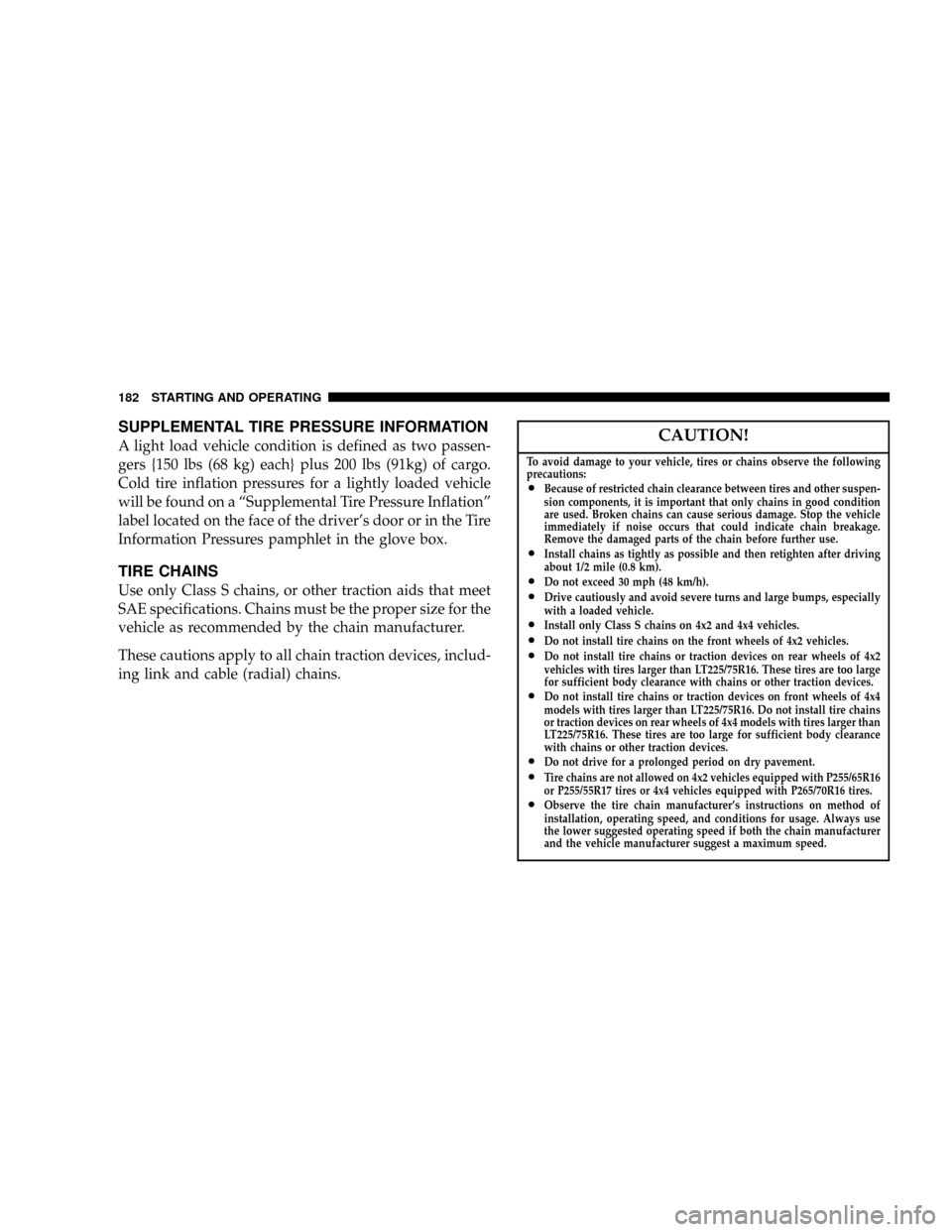2004 DODGE DAKOTA Tire chains
[x] Cancel search: Tire chainsPage 142 of 300

NTire Markings........................167
NTire Identification Number (TIN)..........171
NTire Loading And Tire Pressure...........172
mTiresÐGeneral Information...............175
NTire Pressure.........................175
NTire Inflation Pressures.................176
NRadial-Ply Tires......................178
NCompact Spare Tire Ð If Equipped.........178
NTire Spinning........................179
NTread Wear Indicators..................180
NReplacement Tires.....................180
NAlignment And Balance.................181
mSupplemental Tire Pressure Information.....182
mTire Chains...........................182
mSnow Tires...........................183
mTire Rotation Recommendations...........183
mFuel Requirements.....................184
NReformulated Gasoline.................184
NGasoline/Oxygenate Blends..............185
NMMT In Gasoline.....................185
NSulfur In Gasoline.....................185
NMaterials Added To Fuel................186
mAdding Fuel..........................186
NFuel Filler Cap (Gas Cap)...............186
NFuel Tank Filler Tube...................187
NFuel System Cautions..................188
NCarbon Monoxide Warnings..............189
mCatalytic Converter.....................189
mVehicle Loading.......................191
NCertification Label.....................191
NCurb Weight.........................192
NLoading............................192
142 STARTING AND OPERATING
Page 182 of 300

SUPPLEMENTAL TIRE PRESSURE INFORMATION
A light load vehicle condition is defined as two passen-
gers {150 lbs (68 kg) each} plus 200 lbs (91kg) of cargo.
Cold tire inflation pressures for a lightly loaded vehicle
will be found on a ªSupplemental Tire Pressure Inflationº
label located on the face of the driver's door or in the Tire
Information Pressures pamphlet in the glove box.
TIRE CHAINS
Use only Class S chains, or other traction aids that meet
SAE specifications. Chains must be the proper size for the
vehicle as recommended by the chain manufacturer.
These cautions apply to all chain traction devices, includ-
ing link and cable (radial) chains.
CAUTION!
To avoid damage to your vehicle, tires or chains observe the following
precautions:
²Because of restricted chain clearance between tires and other suspen-
sion components, it is important that only chains in good condition
are used. Broken chains can cause serious damage. Stop the vehicle
immediately if noise occurs that could indicate chain breakage.
Remove the damaged parts of the chain before further use.
²Install chains as tightly as possible and then retighten after driving
about 1/2 mile (0.8 km).
²Do not exceed 30 mph (48 km/h).²Drive cautiously and avoid severe turns and large bumps, especially
with a loaded vehicle.
²Install only Class S chains on 4x2 and 4x4 vehicles.²Do not install tire chains on the front wheels of 4x2 vehicles.²Do not install tire chains or traction devices on rear wheels of 4x2
vehicles with tires larger than LT225/75R16. These tires are too large
for sufficient body clearance with chains or other traction devices.
²Do not install tire chains or traction devices on front wheels of 4x4
models with tires larger than LT225/75R16. Do not install tire chains
or traction devices on rear wheels of 4x4 models with tires larger than
LT225/75R16. These tires are too large for sufficient body clearance
with chains or other traction devices.
²Do not drive for a prolonged period on dry pavement.²Tire chains are not allowed on 4x2 vehicles equipped with P255/65R16
or P255/55R17 tires or 4x4 vehicles equipped with P265/70R16 tires.
²Observe the tire chain manufacturer's instructions on method of
installation, operating speed, and conditions for usage. Always use
the lower suggested operating speed if both the chain manufacturer
and the vehicle manufacturer suggest a maximum speed.
182 STARTING AND OPERATING
Page 197 of 300

Wheel9style trailer, this range of loading on the9King
Pin9should be between 15% and 25%.) Loads balanced
over the wheels or biased toward9heavier in the rear9
can cause the trailer to sway severely side to side
which will cause loss of control of vehicle and trailer.
Failure to load trailers heavier in front is the cause of
many trailer accidents.
²Donotinterconnect the hydraulic brake system of
your vehicle with that of the trailer. This could cause
inadequate braking and possible personal injury.
²Trailer brakes are recommended for trailers over 1,000
lbs. (454 kg) and required for trailers in excess of 2,000
lbs. (907 kg).
²Use an approved trailer harness and connector. If a
hitch is ordered, the proper wiring will be provided.
²When hauling cargo or towing a trailer, do not over-
load your vehicle or trailer. Overloading can cause a
loss of control, poor performance or damage to brakes,
axle, engine, transmission, steering, suspension, chas-
sis structure or tires.
²Make certain that the load is secured in the trailer and
will not shift during travel. When trailering cargo that
cannot be fully secured, dynamic load shifts can occur
that may be difficult for the driver to control.
²All trailer hitches should be professionally installed on
your vehicle.
²Safety chains must always be used between your
vehicle and trailer.
²Connect trailer lighting and brakes using factory har-
nesses only. Do not cut or splice any wiring to the
brake circuits.
Trailer and Tongue Weight
Gross Trailer Weight (GTW) means the weight of the
trailer plus the weight of all cargo and equipment loaded
on the trailer when in actual underway towing condition.
The recommended way to measure GTW is to put your
fully loaded trailer on a vehicle scale. The entire weight
of the trailer must be supported by the scale.
Tongue Weight is the weight placed on the vehicle's
trailer hitch by the trailer. Always load a trailer with 60%
STARTING AND OPERATING 197
5
Page 298 of 300

Transfer Case........................ 151
Transfer Case, Shifting into Transfer
Case Neutral (N).................... 202
Transfer Case, Shifting out of Transfer
Case Neutral (N).................... 204
Shoulder Belt Upper Anchorage............. 29
Signals, Turn......................70,99,256
Sliding Rear Window..................... 23
Snow Chains.......................... 182
Snow Plow........................... 201
Snow Tires............................ 183
Spare Tire............................ 210
Spark Plugs........................... 230
Specifications
Fuel............................... 184
Speed Control.......................... 74
Speedometer.......................... 100
Starting.............................. 144
Emergency (Jump Starting).............. 215
Engine Block Heater................... 146
Steering
Column Controls...................... 70
Column Lock......................... 11Linkage............................ 235
Power...........................166,234
Wheel, Tilt........................... 73
Steering Wheel Mounted Sound System
Controls............................ 130
Storage Compartment, Center Seat........... 89
Storage, Vehicle........................ 254
Stuck, Freeing......................... 167
Supplemental Tire Pressure Information...... 182
Synthetic Engine Oil..................... 229
Tachometer............................ 99
Tailgate............................... 90
Taillights............................. 256
Tape Player........................... 131
Temperature Gauge, Engine Coolant......... 99
Tether Anchor, Child Restraint.............. 42
Thermostat........................... 241
Tilt Steering Column..................... 73
Tire and Loading Information Placard.....172,182
Tire Identification Number (TIN)........... 171
Tire Markings......................... 167
Tire Safety Information................... 167
298 INDEX
Page 299 of 300

Tires ..............................54,175
Air Pressure......................... 175
Alignment.......................... 181
Chains............................. 182
Changing........................... 209
Compact Spare....................... 178
General Information................... 175
High Speed......................... 177
Inflation Pressures.................... 176
Jacking............................. 211
Load Capacity....................... 172
Radial............................. 178
Replacement......................... 180
Rotation.........................183,264
Safety...........................167,175
Sizes............................... 169
Snow Tires.......................... 183
Spare Tire........................... 210
Spinning............................ 179
Tread Wear Indicators.................. 180
Warnings........................... 182
Wheel Nut Torque.................... 213
Tongue Weight/Trailer Weight............. 197Torque Converter Clutch................. 149
Towing
Disabled Vehicle...................... 217
Guide.............................. 199
Recreational......................... 202
Trailering........................... 195
Weight............................. 199
Traction.............................. 206
Trailer Towing......................... 195
Cooling System Tips................... 201
Hitches............................. 198
Minimum Requirements................ 199
Trailer and Tongue Weight.............. 197
Wiring............................. 200
Trailer Towing Guide.................... 199
Trailer Weight......................... 199
Transfer Case.......................... 248
Fluid.............................. 260
Transmission....................146,150,245
Automatic.....................144,146,245
Filter.............................. 247
Fluid........................245,247,260
Manual.......................144,150,245
INDEX 299
10